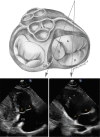The tricuspid valve in review: anatomy, pathophysiology and echocardiographic assessment with focus on functional tricuspid regurgitation
- PMID: 32642207
- PMCID: PMC7330354
- DOI: 10.21037/jtd.2020.02.42
The tricuspid valve in review: anatomy, pathophysiology and echocardiographic assessment with focus on functional tricuspid regurgitation
Abstract
The tricuspid valve (TV) is a complex anatomical structure that incorporates a saddle-shaped annulus, asymmetric leaflets, the subvalvular apparatus and the right ventricle and its loading conditions. In this paper, an appreciation of the normal anatomy and physiology of the TV is reviewed before discussing functional tricuspid regurgitation (TR), a disease that has garnered renewed interest due to increased awareness of adverse outcomes and novel transcatheter therapeutic options. Two and three-dimensional echocardiographic imaging of the TV using transthoracic and transesophageal windows are subsequently discussed. The future of cardiovascular medicine will have more to offer the "forgotten" right-sided chambers and valves, and this review aims to refresh knowledge and enthusiasm around the forgotten but crucially important TV.
Keywords: Tricuspid valve (TV); echocardiography; functional tricuspid regurgitation; three-dimensional echocardiography; tricuspid regurgitation (TR).
2020 Journal of Thoracic Disease. All rights reserved.
Conflict of interest statement
Conflicts of Interest: All authors have completed the ICMJE uniform disclosure form (available at http://dx.doi.org/10.21037/jtd.2020.02.42). The series “Novel Concepts in Cardiopulmonary and Structural Heart Disease” was commissioned by the editorial office without any funding or sponsorship. The authors have no other conflicts of interest to declare.
Figures







References
-
- Hung J, Koelling T, Semigran MJ, et al. Usefulness of echocardiographic determined tricuspid regurgitation in predicting event-free survival in severe heart failure secondary to idiopathic-dilated cardiomyopathy or to ischemic cardiomyopathy. Am J Cardiol 1998;82:1301-3, A10. - PubMed
Publication types
LinkOut - more resources
Full Text Sources
